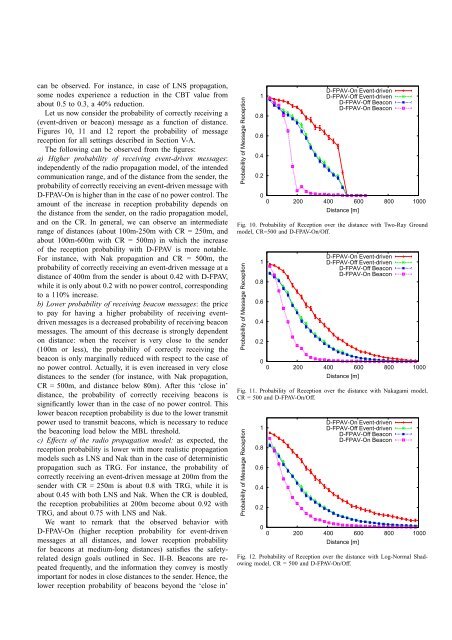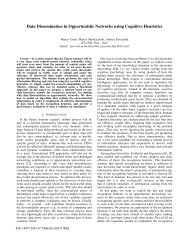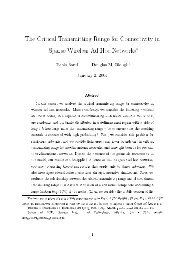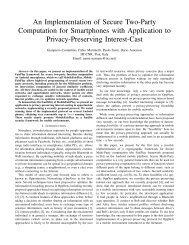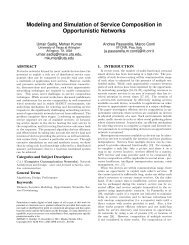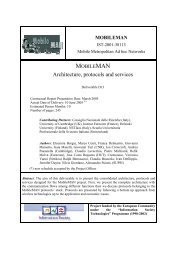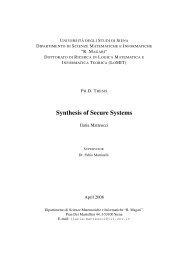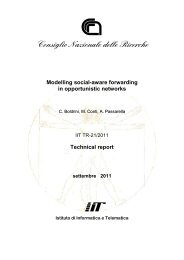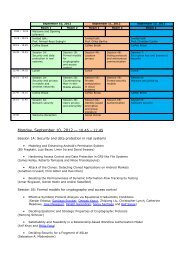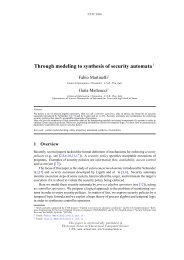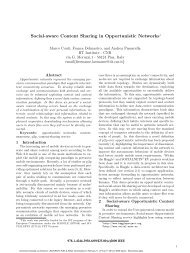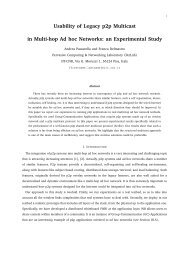Distributed Fair Transmit Power Adjustment for Vehicular Ad Hoc ...
Distributed Fair Transmit Power Adjustment for Vehicular Ad Hoc ...
Distributed Fair Transmit Power Adjustment for Vehicular Ad Hoc ...
You also want an ePaper? Increase the reach of your titles
YUMPU automatically turns print PDFs into web optimized ePapers that Google loves.
can be observed. For instance, in case of LNS propagation,some nodes experience a reduction in the CBT value fromabout 0.5 to 0.3, a 40% reduction.Let us now consider the probability of correctly receiving a(event-driven or beacon) message as a function of distance.Figures 10, 11 and 12 report the probability of messagereception <strong>for</strong> all settings described in Section V-A.The following can be observed from the figures:a) Higher probability of receiving event-driven messages:independently of the radio propagation model, of the intendedcommunication range, and of the distance from the sender, theprobability of correctly receiving an event-driven message withD-FPAV-On is higher than in the case of no power control. Theamount of the increase in reception probability depends onthe distance from the sender, on the radio propagation model,and on the CR. In general, we can observe an intermediaterange of distances (about 100m-250m with CR = 250m, andabout 100m-600m with CR = 500m) in which the increaseof the reception probability with D-FPAV is more notable.For instance, with Nak propagation and CR = 500m, theprobability of correctly receiving an event-driven message at adistance of 400m from the sender is about 0.42 with D-FPAV,while it is only about 0.2 with no power control, correspondingto a 110% increase.b) Lower probability of receiving beacon messages: the priceto pay <strong>for</strong> having a higher probability of receiving eventdrivenmessages is a decreased probability of receiving beaconmessages. The amount of this decrease is strongly dependenton distance: when the receiver is very close to the sender(100m or less), the probability of correctly receiving thebeacon is only marginally reduced with respect to the case ofno power control. Actually, it is even increased in very closedistances to the sender (<strong>for</strong> instance, with Nak propagation,CR = 500m, and distance below 80m). After this ‘close in’distance, the probability of correctly receiving beacons issignificantly lower than in the case of no power control. Thislower beacon reception probability is due to the lower transmitpower used to transmit beacons, which is necessary to reducethe beaconing load below the MBL threshold.c) Effects of the radio propagation model: as expected, thereception probability is lower with more realistic propagationmodels such as LNS and Nak than in the case of deterministicpropagation such as TRG. For instance, the probability ofcorrectly receiving an event-driven message at 200m from thesender with CR = 250m is about 0.8 with TRG, while it isabout 0.45 with both LNS and Nak. When the CR is doubled,the reception probabilities at 200m become about 0.92 withTRG, and about 0.75 with LNS and Nak.We want to remark that the observed behavior withD-FPAV-On (higher reception probability <strong>for</strong> event-drivenmessages at all distances, and lower reception probability<strong>for</strong> beacons at medium-long distances) satisfies the safetyrelateddesign goals outlined in Sec. II-B. Beacons are repeatedfrequently, and the in<strong>for</strong>mation they convey is mostlyimportant <strong>for</strong> nodes in close distances to the sender. Hence, thelower reception probability of beacons beyond the ‘close in’Probability of Message Reception10.80.60.40.2D-FPAV-On Event-drivenD-FPAV-Off Event-drivenD-FPAV-Off BeaconD-FPAV-On Beacon00 200 400 600 800 1000Distance [m]Fig. 10. Probability of Reception over the distance with Two-Ray Groundmodel, CR=500 and D-FPAV-On/Off.Probability of Message Reception10.80.60.40.2D-FPAV-On Event-drivenD-FPAV-Off Event-drivenD-FPAV-Off BeaconD-FPAV-On Beacon00 200 400 600 800 1000Distance [m]Fig. 11. Probability of Reception over the distance with Nakagami model,CR = 500 and D-FPAV-On/Off.Probability of Message Reception10.80.60.40.2D-FPAV-On Event-drivenD-FPAV-Off Event-drivenD-FPAV-Off BeaconD-FPAV-On Beacon00 200 400 600 800 1000Distance [m]Fig. 12. Probability of Reception over the distance with Log-Normal Shadowingmodel, CR = 500 and D-FPAV-On/Off.


